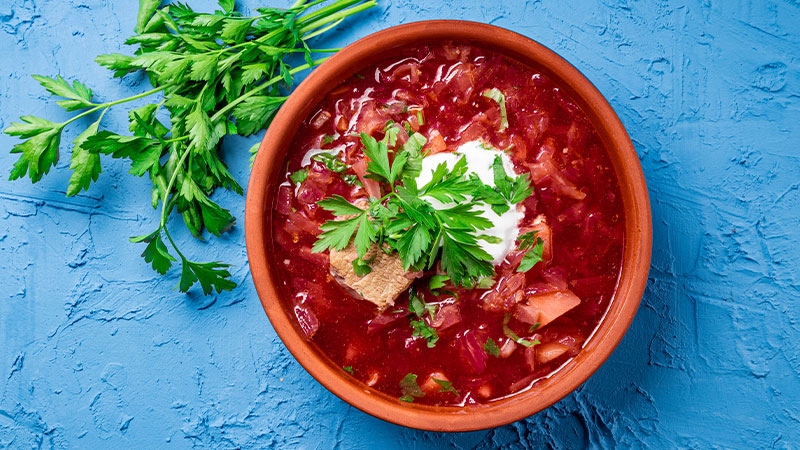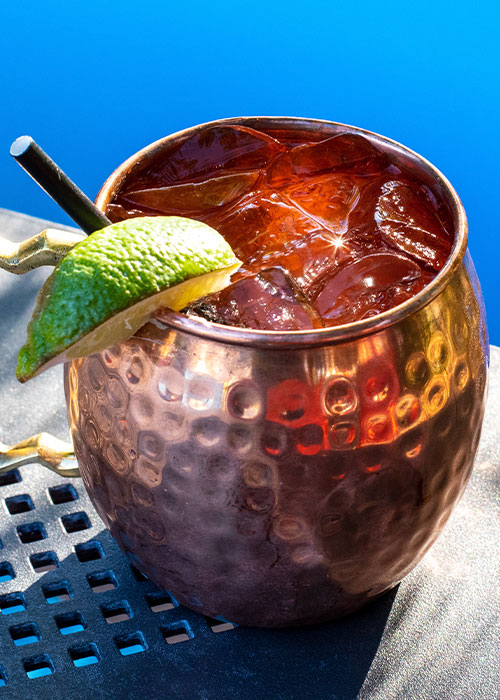There are many etymological instances of alcohol coming to be known as the “water of life.” The word “whiskey” stems from the Gaelic version of this very term; same story for “aquavit.” And so it should come as no surprise that the name “vodka” is an evolution of the Russian word for water, or вода, which is pronounced “vo-da.”
Like the colorful domes of St. Basil’s Cathedral and lines of matryoshka dolls, the mind quickly wanders to Mother Russia following any mention of vodka. But how many of our modern-day associations with the spirit — like say, in the Moscow Mule cocktail, or pairing with caviar — are as authentically Russian?
To answer this question, VinePair tapped Bek Narzi. Born in Soviet-era Russia, Narzi now resides in London where he co-owns and runs the Pachamama restaurant group. Yet his experience behind the bar and influence on Russian cocktail culture is considerable.
Don’t miss a drop!
Get the latest in beer, wine, and cocktail culture sent straight to your inbox.
During the early 2000s, Narzi hosted the Prime Time Cocktail show on the national Russian channel RT, with the segment airing at the very on-brand time of 7:45 p.m. on Friday evenings. Narzi is also a published author with two books focusing on the hospitality industry. And under his helm in 2011, the City Space Bar in Moscow’s Swissotel clinched a spot among the World’s Top 50 Bars.
Suffice to say, Narzi is ideally placed to advise on how to drink vodka in a traditional Russian manner. Read on to discover his sage advice.
How to Drink Vodka Neat
Though vodka has found a home in countless well-known cocktails, for an authentically Russian experience, Narzi says vodka must be drunk neat and as a shot. And when enjoying in this manner, there is but one hard and fast rule: Food must always accompany the alcohol.
“If you’re drinking good vodka and in good company, it can be very dangerous,” Narzi says. “You don’t feel how much you’re drinking, then you pay for it the next morning.”
Traditionally, food arrives in the form of zakuski, Russia’s answer to tapas or mezze. Popular dishes include plates of pickles; roasted or boiled meats, such as ox tongue; horseradish; salads; and, of course, soup — whether borscht (beetroot) or shchi (cabbage). More substantial offerings, from dumplings and meat patties to stews with potatoes, then follow.
With its largely flavorless and odorless profile, there’s no danger of vodka competing with such a wide array of pairing partners. Being cheap and abundant, caviar would once have featured during such occasions, too, though this is no longer the case. “Now it’s become luxurious,” Narzi says. “Russian people eat caviar and chase it with vodka only on New Year’s Eve.”

How to Toast With Vodka in Russian
During get-togethers, diners don’t typically drink shots of vodka at their own leisure because it’s seen as “cheap” to drink without toasting, or without having a reason to do so, Narzi explains. Neither is the toast a simple “cheers,” or the Russian equivalent. “Na zdorovie is bullshit,” Narzi says. “No one in Russia says it.”
Instead, each shot follows a more specific toast. To the host, for example, to the women around the table, someone’s new job, or to health and prosperity in general. A dedicated toastmaster typically leads this aspect of the experience. “Someone charismatic who knows aphorisms, and will keep the crowd interested,” Narzi says of the ideal candidate. “It’s all about rituals.”
In preparation for special occasions like weddings, where there will be many opportunities to toast, Narzi recommends always eating something substantial but not overly filling before the event, like a medium-sized steak. “Do not start this vodka journey on a hungry stomach,” he says.
Vodka Serving Size and Temperature
While a standard shot glass holds 2 ounces in the United States and 50 milliliters in countries where metric measurements are preferred, Narzi warns against a pour this large when drinking vodka. “You need to serve it in smaller shots to extend the pleasure,” he says, recommending 25-milliliter pours (roughly 1 ounce).
Contrary to popular belief, plucking a bottle straight from the freezer isn’t the best for serving temperature, nor is it traditional. Many Russians are afraid to freeze their vodka as it can solidify some of the impurities that “dishonest” vodka brands put into their spirits, Narzi explains. And rather than going down smoother, shooting freezer-cold vodka can actually burn the throat. So Narzi opts to instead keep bottles chilled in a fridge.

Vodka Cocktails
Of course, there’s nothing wrong with enjoying vodka in cocktails but this isn’t an authentically Russian means of enjoying the spirit, Narzi reiterates.
In fact, many of the cocktails that appear to have strong Russian ties are nothing more than marketing gimmicks. The Moscow Mule, for instance, was devised in the United States by Smirnoff and a California bar owner with an excess of ginger beer to offload. As for the coffee-liqueur-laden White Russian: more fiction. “Russians have a tea culture,” Narzi explains. “Coffee culture only came with Starbucks.”
Narzi also adds that, among the current wave of top bartending talent in Russia, there remains a reluctance to use vodka in cocktails. It’s old school, and seen as something of a Soviet-era mom-and-dad drink.
“The traditional way is very simple: You sit. There’s Zakuski. And there has to be a reason to drink vodka,” Narzi says. Of course, those reasons — those celebrations — don’t need to be overly substantial. “They used to sell special calendars with 365 reasons to drink vodka,” Narzi adds, with a hearty laugh.


